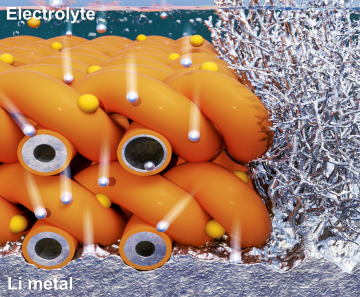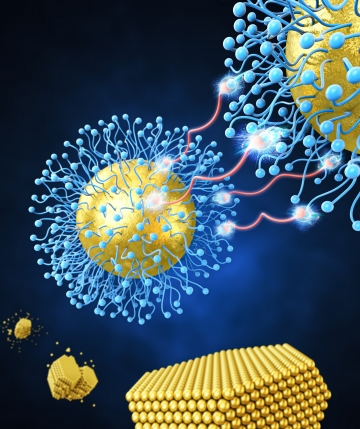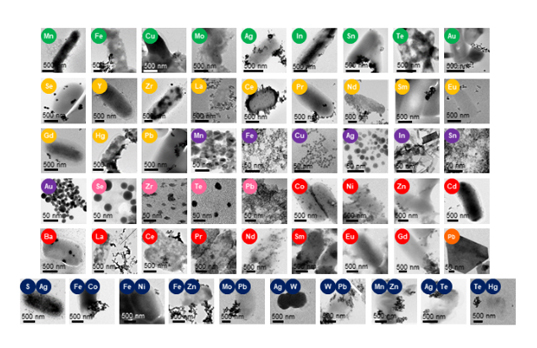KAIST
BREAKTHROUGHS
Research Webzine of the KAIST College of Engineering since 2014
Spring 2025 Vol. 24Recombinant Escherichia coli as a biofactory for the biosynthesis of diverse nanomaterials
Recombinant Escherichia coli as a biofactory for the biosynthesis of diverse nanomaterials
A recombinant E. coli strain that biosynthesizes 60 different nanomaterials covering 35 elements was developed. A strategy using the recombinant E. coli strain provides a new platform for manufacturing diverse industrial nanomaterials in an environmentally-friendly manner.
Article | Spring 2019
Nanomaterials such as metals, metal oxides, carbon nanotubes, graphene, and quantum dots are increasingly used for developing various industrial materials. Nanomaterials mostly synthesized by chemical and physical methods require physically harsh and environmentally hazardous conditions. A recent successful biosynthesis of nanomaterials under mild conditions without requiring physical and chemical treatments has triggered motivation for exploring the full biosynthesis capacity of a biological system for producing a range of various nanomaterials as well as for understanding biosynthesis mechanisms for crystalline versus amorphous nanomaterials.
A research team of Distinguished Professor Sang Yup Lee, Associate Professor Doh Chang Lee, both from the Department of Chemical and Biomolecular Engineering at the Korea Advanced Institute of Science and Technology (KAIST), and Associate Professor Tae Jung Park of the Department of Chemistry at Chung-Ang University addressed this issue. The research team constructed a recombinant Escherichia coli strain that co-expresses metallothionein, a metal binding protein, and phytochelatin synthase that synthesizes metal-binding peptide phytochelatin for the biosynthesis of various nanomaterials. Subsequently, an E. coli strain was engineered to produce a wide range of nanomaterials, including those never biosynthesized before, by using individual 35 elements from the periodic table and also by combining multi-element nanomaterials. Use of a single individual element, including Mn, Fe, Cu, Mo, Ag, In, Sn, Te, and Au, led to the biosynthesis of crystalline single-element nanomaterials (i.e., Mn3O4, Fe3O4, Cu2O, MoO2, Ag, In(OH)3, SnO2, Te, and Au), while the other elements resulted in the biosynthesis of amorphous nanomaterials or no nanomaterial biosynthesis at all.
The research team subsequently analyzed the nanomaterial biosynthesis conditions using a Pourbaix diagram to predict producibility and crystallinity. Pourbaix diagrams were analyzed to predict stable chemical species of each element for nanomaterial biosynthesis at varying levels of reduction potential (Eh) and pH. Based on the Pourbaix diagram analyses, the initial pH of the reaction was changed from 6.5 to 7.5, resulting in the biosynthesis of various crystalline nanomaterials that were previously amorphous or not synthesized. This strategy was extended to biosynthesize multi-element nanomaterials including CoFe2O4, NiFe2O4, ZnMn2O4, ZnFe2O4, Ag2S, Ag2TeO3, Ag2WO4, Hg3TeO6, PbMoO4, PbWO4 and, Pb5(VO4)3OH.
A noteworthy outcome of this study was that this system could be used to biosynthesize 33 nanomaterials (20 single-element and 13 multi-element nanomaterials) for the first time, including a novel crystalline nanomaterial Ag2TeO3. In many cases, the producibility and crystallinity of nanomaterials could be predicted by the Pourbaix diagram analyses, allowing the forward design of nanomaterial biosynthesis of single- and multi-elements of interest.
Various single- and multi-element nanomaterials biosynthesized in this study can potentially serve as new and novel nanomaterials for industrial applications such as catalysts, chemical sensors, biosensors, bio-imaging, drug delivery, and cancer therapy.
This research was published in Proc. Natl. Acad. Sci. U. S. A. (PNAS; 115(23):5944-5949, 2018), and was also highlighted by a number of press media.
Most Popular

When and why do graph neural networks become powerful?
Read more
Extending the lifespan of next-generation lithium metal batteries with water
Read more
Professor Ki-Uk Kyung’s research team develops soft shape-morphing actuator capable of rapid 3D transformations
Read more
Smart Warnings: LLM-enabled personalized driver assistance
Read more
Development of a nanoparticle supercrystal fabrication method using linker-mediated covalent bonding reactions
Read more
